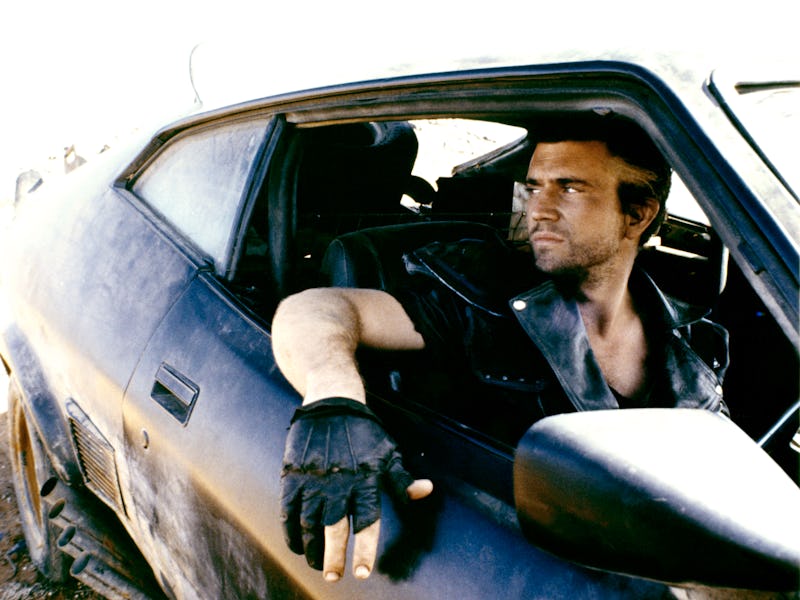No Sci-Fi Franchise Has Made the Apocalypse Quite As Deranged as Mad Max
A world of fire and blood.

Forty-five years ago, Mad Max changed dystopian science fiction forever. But, the funny thing is, after 1979, every subsequent sequel to Mad Max also radically changed the franchise. Because each movie in the Mad Max franchise is a marked departure from the film that preceded it, it’s a sci-fi film series like no other.
As Furiosa: A Mad Max Saga speeds toward movie theaters on May 24, the rest of the Mad Max franchise has just dropped on Max. So, before Furiosa becomes a midquel to Fury Road and the second Mad Max movie, should you watch the rest of this uneven franchise? The answer is a cautious yes. The entire Mad Max saga is worth your time, if only for its utter uniqueness.
Mad Max (1979)
Oddly, the movie that started it all, Mad Max, is aesthetically, the least Mad Max-y of the bunch. While we generally associate the franchise with a post-apocalyptic world in which scavengers roam the desert, the first movie occurs slightly before the complete collapse of society.
In this movie, the titular Max (Mel Gibson) is still a cop, working for the “Main Force Patrol.” In fact, at this point, there are still jails and courtrooms and everything. It’s a rundown future, but the state of society feels closer to the original RoboCop rather than the aesthetic we think of when we think of the Mad Max franchise. Max stops being a cop in this movie and becomes a vigilante, but the unforgettable vibe of the other films really isn’t present here. For decades, some fans have said that you can actually skip this movie, since the sequel, The Road Warrior, is so different. And yet, it’s because of the radical changes to come that watching Mad Max first is actually so essential and fun. Watching this one isn’t about being a completist, it’s about seeing how this kind of pop art can evolve.
Mad Max 2/The Road Warrior (1981)
Time to hit the road with...The Road Warrior.
The 1981 sequel to Mad Max — titled The Road Warrior in the U.S. — is a not-so-low-key reboot of the original film. Yes, the events of the first movie happened, but the framing of Mad Max 2 tells us that basically, a global battle has wiped out any vestiges of society, and now, Max is running around the dystopian desert in his modified GT Falcon muscle car; one of the most obvious visual connections between first and second films.
Mad Max 2, and its sequel, Beyond Thunderdome, also suggest that perhaps what we’re seeing shouldn't be taken at face value in terms of literal canonicity. At this point, the stories of “Mad Max” Rockatansky — and his allies — are more like folklore. But, in terms of George Miller’s visual style in the later films, including Furisoa, the Mad Max format begins here.
Mad Max Beyond Thunderdome (1985)
Thunderdome is the Dune of the Mad Max franchise, and yes, Tina Turner is the best part.
Arguably the most infamous and innovative sequel of all time, the third Mad Max film was easily the best-remembered entry in the franchise before Fury Road in 2015. Co-starring Tina Turner as Aunty Entity, Beyond Thunderdome is the most hardcore dystopian movie — with a fantastic hit single. The song in question is “We Don’t Need Another Hero,” essentially Tina Turner’s version of Whitney Houston's “I Will Always Love You.” With its pop sensibilities, and dystopian gladiatorial contests, Beyond Thunderdome was totally the Hunger Games of its time.
This isn’t to say it's aged particularly well, but the presence of feral children assisting Max will give you Peter Pan and Temple of Doom vibes simultaneously.
Mad Max: Fury Road
Tom Hardy and Charlize Theron brought the Mad Max aesthetic to a new generation.
Smartly, the 2015 sequel/reboot to the entire saga is barely about Max at all. Instead, with Max now played by Tom Hardy in this film, the real star of the film rapidly becomes another road warrior, Furiosa (Charlize Theron). This film is also where the chronology of the films starts to get confusing, and you really have to just tell yourself that what we’re seeing in each film is a kind of story that comes through the filter of a lost record — the Dead Sea scrolls of the Mad Max future. Here’s why: The first two movies are set in an alternate ‘80s, while Beyond Thunderdome is somewhere in the early aughts. But, Max’s tattoo in Fury Road, says it’s been “12,045 days” since the fall of society. That would mean it’s like somewhere in the 2030s, 20240s, or 2050s, in which case, Max looks way too young.
But, this is a feature not a bug of the Mad Max movies. The aesthetic jump from the first movie to the second movie is jarring as hell, and Thunderdome has even bigger changes, mostly because it’s less of a road movie than the previous two. Fury Road went back to basics, but only insofar as those basics exist nearly exclusively in the second movie.
In other words, our shared platonic perception of Mad Max looks like a mash-up between The Road Warrior and Fury Road. This is, why even if Furiosa contradicts a ton of the other movies, it will fit in perfectly.